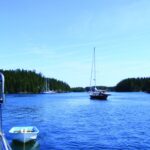Creating a travel guide can be a rewarding experience, whether you’re passionate about sharing your travel experiences or looking to monetize your writing skills. With the abundance of online travel content, it’s crucial to create a guide that stands out, offers value, and is optimized for search engines. This guide provides a comprehensive overview of How To Create A Travel Guide that attracts readers and achieves your goals.
Choosing Your Destination and Defining Your Niche
The first step in creating a successful travel guide is selecting a destination. While popular locations like New York or Paris might seem tempting, they are also highly competitive. Consider focusing on lesser-known destinations or finding a unique angle on a popular one to capture your audience’s attention. Expertise matters! Focus on regions where you have travelled or even better, regions that are your home.
Image of the Eiffel Tower in Paris, a popular travel destination. Alt text: Eiffel Tower from Trocadero Gardens showcasing Paris tourism.
Structuring Your Travel Guide for Maximum Impact
While the style of travel guides can vary, a well-structured guide typically includes essential sections that readers expect. Consider incorporating the following:
1. Getting There: Transportation Options and Tips
Provide detailed information on how to reach your chosen destination, including nearby cities, available modes of transport (air, train, bus, car), and approximate costs. Sharing tips on efficient travel planning and potential money-saving strategies will add value for your readers. For example, is it cheaper to fly or take ground transportation? Are there specific days of the week when flights are cheaper?
2. Accommodation: Hotels, Hostels, and Local Rentals
Offer a variety of accommodation options, ranging from hotels and hostels to local rentals through platforms like Airbnb. Include price ranges and highlight any unique or budget-friendly choices. Sharing tips on finding the best deals and navigating local nuances (e.g., neighborhoods to avoid) can greatly enhance the user experience.
Image of a rental home via Airbnb showcasing accommodation options. Alt text: Cozy Airbnb rental home with a garden view.
3. Tours and Attractions: Must-See Sights and Experiences
Create a curated list of must-see attractions and activities, catering to various interests and budgets. Include everything from walking tours and bus excursions to boat trips and unique local experiences. Draw inspiration from platforms like Airbnb Experiences or GetYourGuide.
4. Getting Around: Local Transportation Options
Provide detailed information on transportation options within the destination, including getting from the airport or train station to the city center. Compare prices and convenience of different methods, such as public transportation, taxis, ride-sharing services, and bike rentals. Consult local residents for insights.
5. Travel Costs: Budgeting and Money-Saving Tips
Outline the expected costs of flights, accommodation, food, transportation, tours, and other travel essentials. Offer practical advice on how to save money and find the best value, catering to budget-conscious travelers.
6. Staying Safe: Safety Tips and Precautions
Address potential safety concerns and provide practical advice on staying safe in the destination. Include information on common scams, areas to avoid, emergency contacts, and local regulations.
7. Best Time to Visit: Seasonal Highlights and Weather
Highlight the best time to visit based on weather, events, and seasonal attractions. Provide recommendations for different times of the year, catering to various interests and preferences. For instance, mentioning when Japan’s cherry blossoms are in bloom.
8. Food and Drinks: Local Cuisine and Recommendations
Showcase the local cuisine and recommend must-try dishes. Suggest specific restaurants, markets, and shops with positive reviews. Explore local food markets for unique and affordable options.
Image of La Boqueria Market in Barcelona, Spain showcasing local food and variety. Alt text: Vibrant La Boqueria market in Barcelona with colorful food stalls.
Best Practices for Writing a Compelling Travel Guide
To create a travel guide that truly resonates with readers, consider these best practices:
1. Visual Appeal: High-Quality Images and Multimedia
Incorporate high-quality images and multimedia elements to enhance the visual appeal of your guide. Images break up text, improve comprehension, and keep readers engaged. Use your own photos or source them from royalty-free stock photo sites or social media (with permission).
2. Keyword Research: Optimizing for Search Engines
Conduct thorough keyword research to identify relevant keywords that potential readers are searching for. Use tools like Google Keyword Planner, SEMrush, or Ahrefs to find keywords related to your destination and target audience. Then, integrate these keywords naturally into your content, including titles, headings, and body text.
3. Strategic Use of Affiliate Tools for Monetization
Incorporate affiliate links, widgets, and banners to monetize your travel guide. Partner with travel brands like Booking.com, GetYourGuide, or TripAdvisor through affiliate programs like Travelpayouts. Ensure that all affiliate tools are relevant and add value for your readers.
4. Choosing the Right Format: Blog Post, PDF, or eBook
Decide on the most appropriate format for your travel guide based on your goals and target audience. Options include blog posts, PDF guides, or eBooks. Create a dedicated section on your blog for travel guides, organized by country or region.
Conclusion: Share Your Passion and Help Others Explore the World
Creating a travel guide requires careful planning, research, and attention to detail. By following the steps outlined in this guide, you can create a valuable resource that inspires others to explore the world and helps you achieve your writing and monetization goals. Remember to focus on providing accurate, helpful, and engaging content that reflects your passion for travel.

